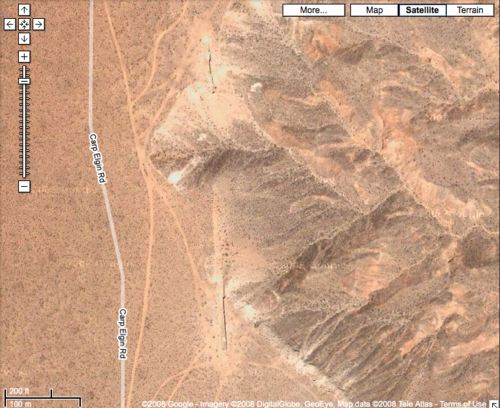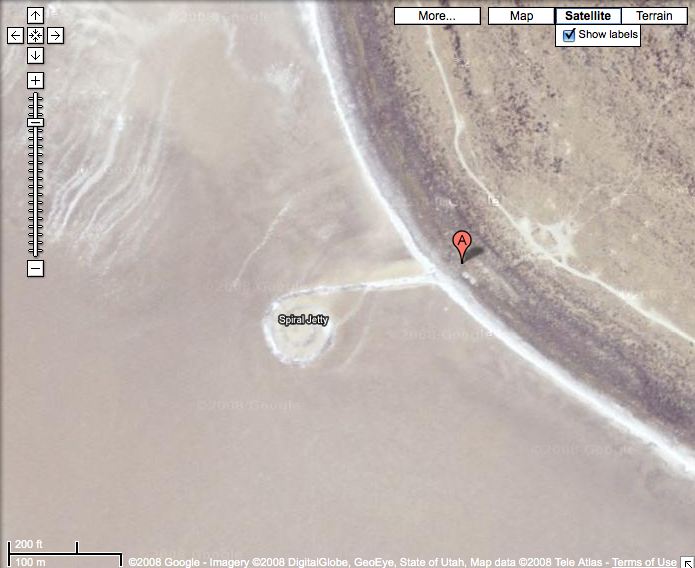Not since we programmed it into the navigation system of my in-laws’ car, anyway.
The car also has an offroad navigation feature that logs virtual GPS breadcrumbs at preset intervals along the way, but it proved unnecessary. The nearly featureless mesa where Heizer’s land artwork is sited turns out to be a road with a name: Carp Elgin Rd.
In fact, there it is on Google Maps, one of the tightest satellite shots I’ve ever seen of Double Negative. Crazy.

Update: OK, not to get all George Bush and the Grocery Scanner about it, but I just typed “Spiral Jetty” into Google Maps, and it came right up. With an upgraded photograph–and a label.

In fact, here are complete driving directions to the Jetty from 213 Park Avenue South, the former location of Max’s Kansas City. [note: there is a weird little, unnecessary jog at the very end that I couldn’t fix, but I’m not worried. Given the rate at which technology is iterating and altering the way once-isolated land artworks are experienced and perceived, I expect a realtime Google Streetview of the Jetty is already being planned on a whiteboard somewhere in Mountain View.]
Clearly, Google has been augmenting its map search with information found on the rest of the web. An otherwise seemingly Googleproof project like Michael Heizer’s City, which he sited as remotely as he could, is pinpointed by latitude and longitude coordinates published on a Land Art site. City also has newer photos.
Roden Crater’s there, under “Roden Crater, AZ,” but it still has the quaint, old-timey satellite photo from 2005 or whatever. I hope they’ll get around to upgrading it by the time Turrell finishes.

Category: google
Earth Art Via Satellite
[via land+living]In the wake of Google Maps’ release, a few sites have started collecting coordinates and satellite images of various earth art works, including Spiral Jetty, Michael Heizer’s Double Negative, James Turrell’s Roden Crater, and Walter deMaria’s Lightning Field.
Here’s my own contribution, a Google Map view of The Chinati Foundation in Marfa, TX. You can see Judd’s large concrete sculptures lined up in the field, the twin barrel vaulted warehouses with milled aluminum boxes inside, the arcing row of converted barracks-installations, and the Judd-altered gymnasium on the left.
Looking for Earth Art With Google Maps [petermorse.com.au]
Monumental Land Art [daringdesigns.com]
Chinati Foundation [chinati.org]
Every Building On The Sunset Strip–And Then Some
 When I saw Amazon’s A9 Local yellow pages feature, the first thing I thought of was Ed Ruscha’s 1966 artist book, Every Building on The Sunset Strip. It was the first Ruscha book I bought, and it makes me laugh to remember how I thought I paid too much for it way back when (it’s easily 10 times as expensive now).
When I saw Amazon’s A9 Local yellow pages feature, the first thing I thought of was Ed Ruscha’s 1966 artist book, Every Building on The Sunset Strip. It was the first Ruscha book I bought, and it makes me laugh to remember how I thought I paid too much for it way back when (it’s easily 10 times as expensive now).
Anyway, using Mikel Maron’s A9 whole-street-grabbing script, I tried all through that weekend to re-create Ruscha’s Sunset Strip. The result was a lot of technical annoyance.
First, starting from a given address, Maron’s script grabs an entire street–a damn big proposition in the case of Sunset Blvd. (Technically, The Strip itself is only a fragment, the section from Doheny to Crescent Heights, from Gil’s Liquors to the Virgin Megastore.)
Trying to save the giant series created some odd results: one seemingly random image would intersperse itself all the way along. After trying to edit this one out, the resulting series were suddenly non-continuous. Something odd was happening when I saved the series and then reconstituted it.
I hadn’t yet cropped the image series at the appropriate intersections, so I didn’t get to try knitting them together into two long panoramas. Actually, I found the A9 images’ redundancy kind of nice; the periodic picture-taking indirectly revealed the (non)movement of the traffic along the Strip.
Anyway, then I saw Jason pointing to Eric Etheridge’s discussion of Every Building, and I think, better to throw this out to the lazyweb and see if someone can tell me how to figure this out, or just do it and make their own selves net-famous.
“Damn you!” campaign results
“Damn you!” campaign results (source: Google Adwords)

Findings:
The greg.org “Damn you!” ad
The greg.org “Damn you!” ad campaign on Google is just about half-over, and the results are rather interesting. (The launch is mentioned in this post.)
The campaign appears on searches for the names of directors who inspired/influenced me, either stylistically or professionally (or both). Since all these directors have turned up here during the making of Souvenir November 2001, I figured ads using their names wouldn’t be gratuituous, but relevant. In addition, I figured someone who searches for a director’s name (especially one of these directors) would be a nice audience for the site and the movie; they’re presumably interested not only in independent film, but in the filmmaking process, too. And if we share interest in these directors specifically, well… Here’s an example of the ads:
Damn you, Wes Anderson!
You made me want to make a movie,
so I did. click to read about it.
greg.org
I spent $10 for each name/ad combination, which, bought about 7-800 impressions (at the retail $15CPM). With this spending cap, the duration of each ad was determined by the frequency of Google searches for each director’s name. Next: results data and analysis for the campaign.
All that Adwords talk got
All that Adwords talk got me thinking, so I climbed in bed with Google myself (or went into the alley behind a dumpster with it, anyway). I launched a small campaign, titled “Damn you!” to promote the movie. In it, I faux-curse some of the directors whose work/example inspired/encouraged me to get off my butt and make a movie.
Each ad starts out, “Damn you, < insert director's name here >!” which is not a reference to Happy Gilmore, or even to Homer Simpson, although you’re getting close. It fell from the lips of God’s (and the NRA’s) anointed, Charlton Heston, in the last scene of Planet of the Apes.
Testing my campaign, I found this article on Apple’s site about the production of Steven Soderbergh’s new film, Full Frontal.
Full Frontal, as you can read, was made with nearly the same level of equipment (DV and Final Cut Pro) as Souvenir November 2001. And in just four months. 18 days of shooting. $2 million budget. With Julia Roberts, David Duchovny, David Hyde Pierce and Catherine Keener. There’s a website that documents the production of the film, week by week.
Now, if you have trouble telling the difference between Souvenir and Full Frontal, just remember: Full Frontal‘s shot in PAL with DAT sound. Souvenir was shot in NTSC with MD sound.
Poetry using Google Adwords: One
Poetry using Google Adwords: One more non-traditional (at least by contemporary standards) medium for creative expression (besides ebay and amazon reviews, which I mentioned last week.) The difference with adwords, of course, is that it costs you money ($15/thousand views these days). This guy did it in April. I did it in February. 2001.
There are two creative elements of an ad on google, of course: the ad itself, and the keywords it appears on. To drive a little traffic to my site (and to amuse myself, really) I set an ad to appear on searches for “haiku.” It wasn’t that the site that has anything to do with haiku, it was Google’s adword format–which had launched at the end of 2000–which clearly resembled haiku:
Invite visitors
to my cluster of sites
through keyword purchase
While editing this post, I found an interesting article from the Online Journalism Review on the emergence of text ads.

